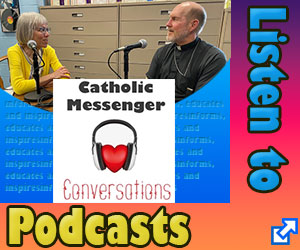
By Deacon Frank Agnoli
Last week, our series began with a brief explanation of why we are getting a new Missal (the book of prayers that the priest uses at Mass, formerly known as the sacramentary) at this time in the church’s life. In this column, I would like to explain why the church has used various languages in its history and how the new Missal is being translated.
A history of liturgical languages
I am sure that it will not come as a surprise to anyone to say that the church has not always prayed in English — or Latin! Jesus prayed and preached in Aramaic, as did his earliest followers. As the infant church moved out of Palestine, Greek became the language of the writing and proclaiming that eventually became the New Testament. As the church grew and spread throughout the Roman Empire, Greek became its language for worship as well. Eventually, Greek came to be understood by fewer and fewer people in the West — so the church (by the end of the 200s) shifted its language for prayer to the vernacular, the language of the people: Latin.
In the East, the liturgy and the Scriptures were translated into Coptic, Syriac, Armenian and eventually Slavonic.
The Roman Catholic Church kept Latin as its official language, a decision renewed at the Council of Trent (1545-1563). Yet, before and after this Council, limited permission to use the vernacular language was given to different communities around the world: Chinese, Arabic, Armenian, Iroquois, Croatian, Slovenian, French, Hindi and English (for details, see the article by Father Dan Merz posted on our Web site: www.davenportdiocese.org/lit/liturgylibrary/litMerzArticle1.pdf).
The Second Vatican Council (1962-1965) broadened the possibility for using vernacular languages in the liturgy, leaving it up to conferences of bishops to ask for that permission. The response was overwhelmingly positive as the church around the world embraced the promise of doing what the church had done from the very beginning: pray in the language of the people.
Of course, Latin remains the official language of the Roman Catholic Church. It gives us a common language that we can use across boundaries (important when we are celebrating the liturgy with representatives from a number of different language groups) and roots us in our tradition. Our liturgical books are first written in Latin, which means that they have to be translated.
The rules for translation
After Vatican II, church leaders produced a new Missal —using prayers that were centuries old as well as new compositions. These texts, all in Latin, had to be translated into the various vernacular languages.
The initial translations were done according to the principle of “dynamic equivalence.” This means that translators have focused on trying to capture the wider meaning of what is being said in the Latin more than on the words or style of the Latin itself. After 30-plus years of experience with these translations, we have come to realize that such an approach is not without problems. While no translation is ever perfect, the current wisdom of the church is that a more literal rendering of the Latin is needed for a number of reasons. Therefore, this new translation is being done according to the principle of “formal correspondence”— a more literal approach that tries to reflect the words and structures used in the original Latin more completely.
The process of translation
Far from being the work of a few isolated individuals, the new translation is an intensive process involving hundreds of individuals and extensive consultation. Here’s how it works: The original Latin text is sent to the International Commission on English in the Liturgy (ICEL). ICEL is made up of a bishop from each of 11 English-speaking Episcopal conferences. While the commission itself is made up of these 11 bishops, they staff the ICEL Secretariat with liturgical experts from around the world. The ICEL staff and bishops work together to produce a first draft (Green Book), which is sent to English-speaking bishops around the world for review. ICEL takes the feedback it receives and produces a second draft (Gray Book), which is again sent to the English-speaking Episcopal conferences for review and approval. Once each of the English-speaking bishop’s conferences approves the texts, they are sent to the Congregation for Divine Worship and the Discipline of the Sacraments (CDWDS) in Rome for final approval (known as the recognitio).
To date, only the Order of Mass has made it all the way through. Everything else is at the “Gray Book” stage — with the final installments scheduled for vote at this November’s meeting of the U.S. Bishops. As you can see, this is an extensive and time-consuming process. Liturgical, linguistic, theological and pastoral experts — lay and ordained — are consulted all along the way, from the level of the local bishop and his staff, to national conferences, and up to the level of ICEL and the CDWDS. The new Missal is, indeed, the work of the church.
A more detailed explanation of the steps involved in the translation process is available on the diocesan Web site at http://www.davenportdiocese.org/lit/liturgylibrary/litTranslationSteps.pdf.
Next time: OK, so what are some objections to the new Missal?








